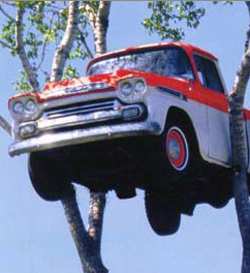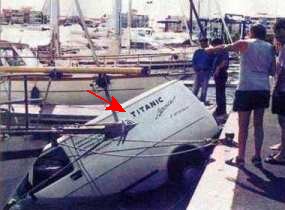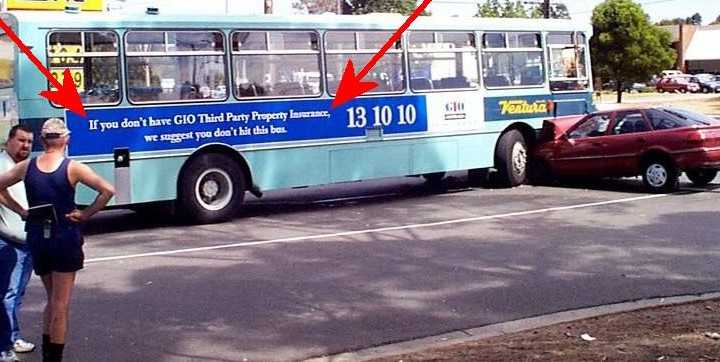Ten Smart Safety Habits
- Always buckle up.
Seat belts halve your
chance of death and reduce serious injuries to minor ones.
- Drive clear-headed.
15% of habitual drunk drivers
eventually die in a traffic accident; most others end up in a wheelchair or in jail.
- Drive cool-headed.
Two-thirds of fatal accidents involve risky driving maneuvers that are often done in a
frustrated, impulsive or negatively emotional state of mind.
- Eyes on the road.
About half of all auto accidents involve distracted drivers. Don't fiddle with anything else while driving: if you let this slide, eventually something will distract you enough to kill or maim you.
- Keep looking ahead.
Don't just concentrate on the car in front of you,
watch the traffic in front of that car too. This improves your chance of seeing a problem soon
enough to save you from an accident.
- Maintain a safe distance.
Donít tailgate, and try to stay
well behind other cars to allow enough room to stop. The "three second
rule" is useful: When the car ahead of you passes some object start counting to three,
and if you don't pass that same object in three seconds, you're safe.
Get away from any cars that appear to be driven unsteadily.
Be aware of cars in adjacent lanes: Sometimes drivers forget to
look back before changing lanes.
- Know your limits.
Driver fatigue or drowsiness is a factor
in about 25% of accidents. If you're tired, don't play Russian Roulette
with your life: pull over and rest.
- Navigate intersections carefully.
In urban areas, 65% of accidents occur at intersections. Even
on a green light, look both ways first.
| |
Spoof Tip #2: park alongside other cars...
...not on top of them
| |
- Avoid the "fast lane."
Most fatal crashes
occur at higher than average speeds. The left lane of highways is
where most highway accidents occur, and staying off it will give
you more ways to escape danger if you encounter a problem ahead of you. And
remember, you're more likely to be noticed by police patrols in the "fast lane."
- Maintain your car well.
Follow the manufacturer's recommended maintenance schedule
to ensure that your car doesn't break down. Inflate your tires to the correct pressure once every few
months. This
will help prevent a tire blowout or a rollover accident, and it can also improve gas mileage dramatically.
|
Safe Driving For All Ages
- Infants.
Make sure the baby has been fed first. Pack soft toys that will not cause much
distraction if thrown. Play tapes or CDs that you have found
tend to comfort the baby. If possible, have someone sit with
the baby.
- Toddlers.
Give each child a bag or pack to be used only
while traveling, containing a variety of items that will occupy his or her
attention quietly. You can include picture books, coloring books, drinks and snacks that
won't spill or crumble, blankets, and stuffed animal toys.
- Older children.
You can give them jobs such as
planning navigation and giving directions. They can
play travel versions of popular games, or make up games such as
looking for license plates. They can keep a notebook to write
in and keep brochures and other free items from the places you visit.
It helps to play audio books, CDs or DVDs (they can each
wear their own headphone.) If it's a long trip, keep blankets and pillows
for napping (but be sure they remain buckled in. )
- Teens.
In the early teen years, teach them about good driving by discussing
the behaviors of other drivers, good and bad. Later on, consider letting them
do some of the driving. We suggest that teens visit
Just One Night to learn the
scary truth, while adults should visit Drive For Life --
Safety Tips to prepare teens to become good drivers.
- Seniors.
The special concerns of our respected seniors
are well covered by the AARP's Driver Safety.
It's a big resource -- some shorter pages for seniors are AARP's
frequently
asked questions and/or senior safety
quiz.
|
| |
Spoof Tip #4: When you drive home...
...try not to drive into your home!
| |
Driving In Bad Weather
Over 20 percent of crashes are weather-related, so avoid
driving in bad weather if you possibly can. If you can't,
here's how to handle the treacherous road conditions
caused by wet or frosty weather:
- Ensure good visibility.
Clear and defog all windows. Turn on your headlights to help you see the road, and more importantly, it helps other motorists see you.
- Drive slower.
This is especially important on the curves.
- Allow more room.
Double the distance you normally allow between you and the car in front of you.
- Brake much earlier and more gently.
This gives you more time to stop and lets the driver behind you know that you're slowing down.
- Steer smoothly.
Changing lanes too quickly or turning the steering wheel fast at normal speed could cause skidding.
- Don't use cruise control.
It allows drivers to be less vigilant, and if your car loses traction you could actually accelerate.
- If you start to skid out...
Don't brake or turn suddenly because that will just make it worse. Release the gas and steer straight until the car regains traction.
- If it gets really bad...
If
you have trouble seeing ahead your car's stopping distance, get off the road if possible.
|
Driving Through Fog
- Use low beams.
Keeping your headlights set to high-beam tends to
reflect off the fog, creating a "white wall" effect.
- Keep a window open.
This lets you listen for nearby traffic
that you might not see. You'll only need to open it an inch or two.
- Be alert to bad patches.
Fog can go from a light mist to a thick blanket in an instant. It
can also leave roadways slick.
|
| |
Spoof Tip #6: There's a new traffic
hazard on the road -- can you spot it?
| |
Driving In Wet Weather
- How to avoid puddles.
A puddle might hide a big
pothole or worse. Most roads rise towards the middle, so drive in
the leftmost lane to avoid most puddles.
- In flood-prone areas...
If
you live in a flood zone, get your car high and dry.
Plan now for your best evacuation route from
a possible flood or hurricane. Do not try to cross
running water, it often is deeper than it looks.
|
| | | |
| |
Spoof Tip #1: Try to stay on the road
| |
"Beware The Dark Side..."  At night you are three times as likely to get into an accident. Here's how
to stay safe:
At night you are three times as likely to get into an accident. Here's how
to stay safe:
- Keep your windshield clean.
At night, a dirty windshield becomes
much harder to see through.
- How to use high beams.
They give you more time to see and react to hazards, but of course they should be
switched off when oncoming traffic approaches.
If an oncoming vehicle doesn't lower its high beams, avoid glare by
concentrating on the right edge of the road as your steering guide.
- Carry an emergency kit.
If your car breaks down, you'll need flares or reflectors to warn other cars. Also consider a flashlight, fix-a-flat kit, maps, white cloth to tie to the antenna to signal distress, and a cell phone.
- If you get tired...
There is no substitute for getting some sleep --
caffeine, loud music and rolling down windows don't improve your judgment.
- Drive extra carefully!
Joyriding teens and drunk drivers are more common, so
drive more defensively as the night gets late. Try
to keep most of your driving to daytime hours.
- Beware of unknown drivers.
"Bump and rob" artists sometimes stage accidents to lure
unsuspecting drivers out of their cars to rob them. Get out of
your car only in public places.
|
| |
Spoof Tip #3: Cars don't float very well...
...especially ones named "Titanic"
| |
Ten Best Safety Technologies
Here they are, starting with the simplest ideas and moving up
to the newest high-tech gadgets:
- A bright car color.
You want to be as visible to other drivers as possible.
A New Zealand study
estimated that white cars are about half as likely
to have an injury-causing accident as hard-to-see cars colored
green, brown or black. What's more, silver-colored cars
were considered to be twice as safe as white cars! - Head restraints.
Also called headrests, they prevent whiplash if adjusted correctly (the top of each headrest should be just below the top of the head.)
- Child safety seats.
Every state now requires them (check state
requirements -- some states require them for kids up to age eight.) But many safety seats are used incorrectly so know how to install them (and here's a video guide.)
- Animal-warning whistles.
You stick these five-dollar gadgets
on the front of the car and not only will they warn pets away, they'll prevent large
animals from doing life-threatening damage to your front end.
- Good tires.
Don't let them become overworn, and in any
area that gets even occasional snow it's best to use all-weather tires. If you
have to drive in snow much, get snow tires -- they have about 20% better traction
than all-weather tires. The Tire
Decision Guide at Tire Rack can help you find good tires.
- Crash-resistant construction.
The government and
the insurance industry both conduct crash tests. For a good explanation
see this Edmunds.com article What Crash Test Scores Mean.
- Airbags.
Driver-side airbags became mandatory in America in 1991, and in 1998 passenger-side airbags were mandated. Side airbags give added safety, but they are not very common yet.
- Anti-lock brakes (ABS).
These systems prevent the car from
skidding when you're braking hard. They're
standard on most cars.
- Electronic stability control.
These systems have been shown to decrease traffic fatalities by 15% for most cars, and 25% for SUVs. They're standard on about half of all models, and will be required on all new vehicles by 2012.
- Advanced safety gear.
If you're willing
to spend money on a really safe car, read this
smart
high-tech safety list from Edmunds.com.
|
| |
Spoof Tip #5: Drunk drivers are special people...
...they find parking spaces no one else ever could!
| |
Driving On Icy Roads
- Be extreeemely careful.
At anything close to
normal speed you'll eventually hit a really slick patch
and go off the road, and no high-tech
braking system or four-wheel drive is going to prevent it.
- Foresee hazardous spots.
Shaded areas often freeze first, while bridges and overpasses can freeze fast and stay frozen there is no solid ground to insulate them.
- Watch for hidden ice.
Snow may conceal a
very slick and treacherous surface underneath. Even if no snow is on the ground, black ice is possible
in cool weather. These areas will appear black and shiny, and they can be very slick indeed.
- Use low gears.
This will help you keep traction, especially on hills.
|
Driving In Snow
- Warm up your car in advance.
This reduces condensation on the inside of the windows, which can block your vision. Never warm up your vehicle in a closed garage because of the risk of carbon monoxide poisoning.
- Don't underestimate the danger.
It's
not worth the risk to drive in bad winter weather
if you can avoid it. At least wait until the roads have been sanded, if you possibly
can.
- Plan for emergencies.
Always carry a jumper cable, warm clothes, first aid kit,
food and drink, spare gas and motor oil, sand or salt, and a cell phone if you have one.
- If you get stuck...
Don't spin your wheels, because that just makes
the surface slicker. It's better to clear away some snow and ease out slowly.
Pour sand or salt, or lay down nearby twigs or branches to increase traction.
You can also try "rocking out" the vehicle by quickly shifting from forward to reverse and back again.
|
|









